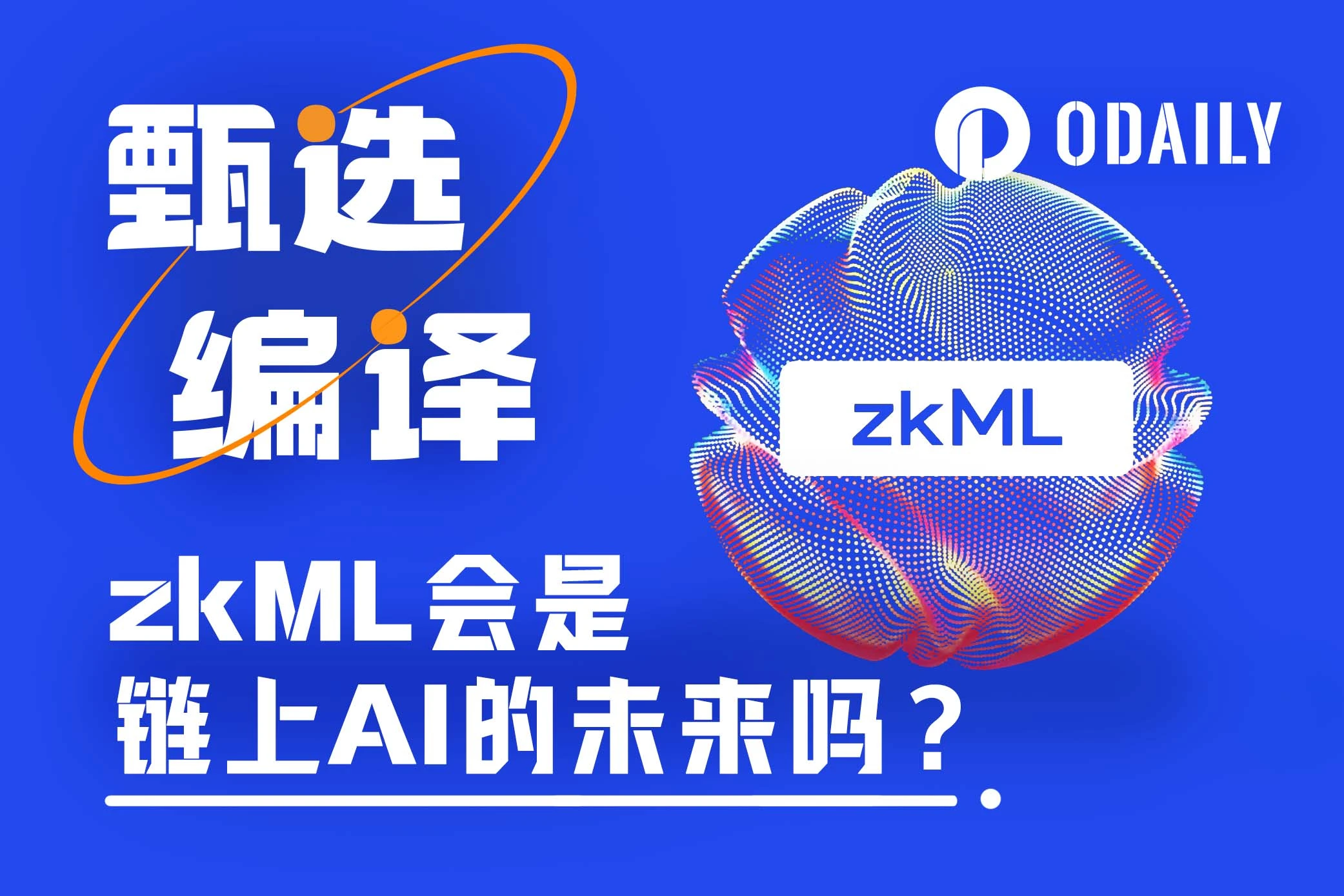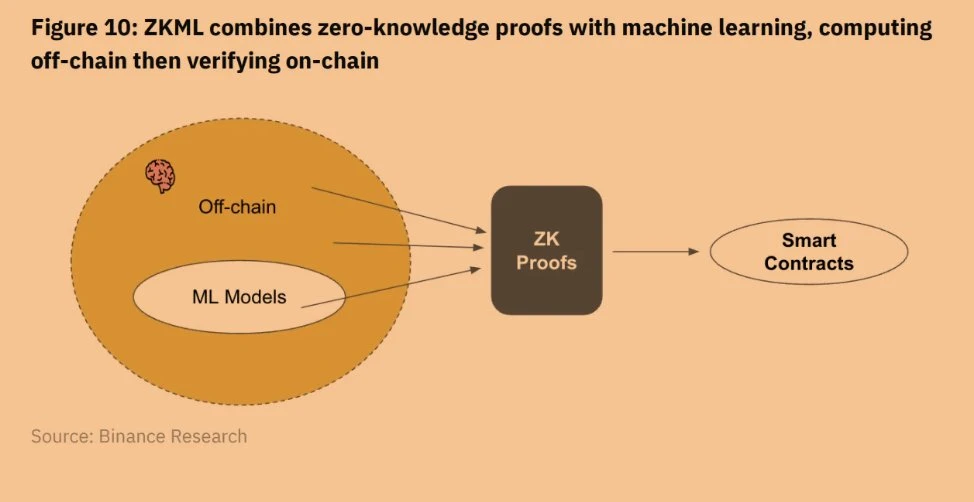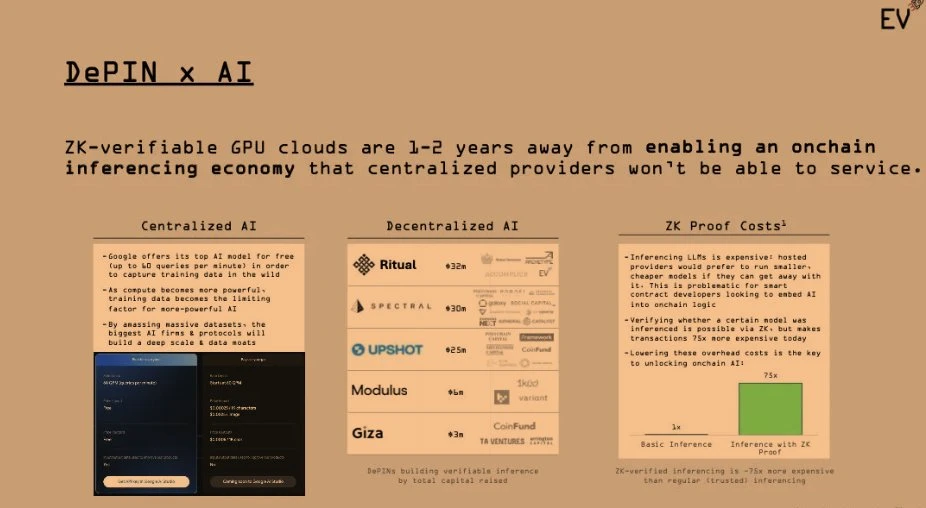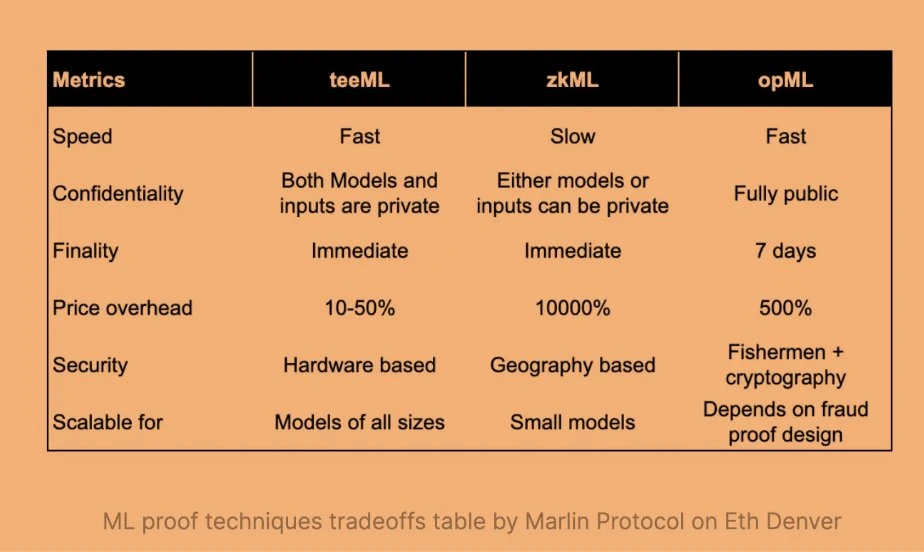原作者 | 翻訳者
コンピレーション | ゴーレム
ChatGPTのような大規模言語モデルの人気が高まって以来、同様の機械学習モデルを分散ネットワーク上で実行することが ブロックチェーン + AI の主な物語の 1 つになっています。ただし、OpenAI のような評判の良い企業を信頼するのと同じように、分散型ネットワークが推論に特定の ML モデルを使用することを信頼することはできないため、検証する必要があります。データのプライバシーを考慮すると、ゼロ知識機械学習 (zkML) は一般的に楽観的ですが、オンチェーン AI の未来となるのでしょうか。
この記事では、Odaily Planet DailyがzkMLに関する基礎知識を簡単に紹介します。 注目に値する zkML プロジェクトについて説明し、最後に zkML の制限と代替ソリューションについて簡単に説明します。
zkMLに関する基礎知識
ゼロ知識機械学習 (zkML) は、コンピューティングにおける機密性アプローチに似ています。主に 2 つの部分で構成されます。
-
機械学習 (ML) を使用してタスクを実行します。
-
すべての詳細を明らかにすることなく、タスクが正しく完了したことを証明します。
簡単に言えば、仕組みは次のようになります。
a. タスクを実行する
誰かが ML モデルを使用してデータを処理して結果を取得します。これは、シェフがレシピに従ってケーキを焼きながら、材料を誰にも伝えないようなものです。
b. 証明タスク
タスクが完了すると、証明を示すことができます。たとえば、この特定のモデルでこの特定の入力を使用して、この結果を得ました。実際に、レシピの手順を正しく実行したことを証明しているのです。
c. 機密性を保つ
zkML の優れた点は、タスクが正しく実行されたことを証明するときに、入力データ、モデルの動作、結果などの詳細の一部を非公開にできることです。つまり、zkML を使用すると、証明者はメソッドとデータを非公開にしたまま、「私を信じてください。正しく実行しました」と言うことができます。
注目すべきzkMLプロジェクトの紹介
zkMLのコンセプトが提案されてからほぼ1年が経ちました。現在、多くの関連プロジェクトが構築中であり、そのうちのいくつかは市場にトークンを発行しています。 メッサーリ 有名な VC が投資した zkML プロジェクトをいくつかリストアップしましたので、以下に紹介します。
出典: メッサリ
スペクトル
スペクトル は、Web3 用のオンチェーン エージェント エコノミーを構築しています。同社の主力製品である SYNTAX は、Solidity コードを生成する独自の LLM (Large Language Model) です。Spectral を使用すると、ユーザーはオンチェーンの自律エージェントを作成し、分散型 ML 推論を活用してスマート コントラクトを改善できます。さらに、zkML を使用して、Spectral は特定の予測が特定の ML モデルによって生成されたという証拠を提供し、プロセスの信頼性と信頼性を確保できます。
Spectralは、時価総額$1億1,900万のSPECと呼ばれるトークンを発行しました。
ワールドコイン
ワールドコイン 誰もが世界経済に参加できるようにすることを目的としたオープンソースシステムを開発しています。Worldcoinでは、zkMLの潜在的な用途の1つは、虹彩認識技術のセキュリティとプライバシーを向上させることです。トークンWLDの市場価値は現在$10.7億です。
仕組みは次のとおりです:
a. 生体認証セルフホスティング
World ID ユーザーは、虹彩スキャンなどの生体認証データをモバイル デバイスに安全かつ暗号化して保存できます。
b. ローカル処理
ユーザーは ML モデルをデバイスにダウンロードし、虹彩スキャンから一意のコードを生成できます。
c. プライバシー保護の証明
zkML を使用すると、デバイス上で直接証明を作成できます。この証明により、虹彩コードが正しいモデルを使用してスキャンから正確に生成されたことが確認されます。これらはすべて、ユーザーの実際のデータを公開することなく実行されます。
リスクゼロ
RISCゼロ 当事者間の信頼を必要としないコンピューティング サービスを提供することで、インターネット上の信頼性と効率性を高めることを目指しています。
RISC Zero の重要なポイントは次のとおりです。
a. ブロックチェーンのスケーリング
Bonsai Proof Service を使用して複雑な操作を実行し、ブロックチェーンのセキュリティを強化します。Bonsai は複雑な計算とプライベート データをオフチェーンで管理し、効率を向上させます。
b. Spice AIとの連携
スパイスAI マネージド クラウド スケールの Spice.ai OSS を含む、すぐに使用できる構成可能なデータおよび AI インフラストラクチャを提供します。このコラボレーションは、開発者に包括的な zkML ツールキットを提供することを目的としています。
c. 機械学習サービス
開発者は RISC Zero を使用して、データに安全にアクセスしてクエリを実行し、ML モデルを非公開でトレーニングし、データが正しく処理されたことを証明できます。
基本的に、RISC Zero は、データと実行プロセスのプライベート性と安全性を確保しながら、開発者に MLaaS (ML as a Service) サービスを提供します。
ギザ
ギザ Starknet ネットワーク上で実行される機械学習プラットフォームです。
a. 主な目的
Giza は、ブロックチェーン上で直接 ML 操作を拡張することを目指しています。
b. 技術的根拠
ゼロ知識 (ZK) 証明をサポートする Starknet を使用して ML 操作を検証し、基礎となるデータを漏らすことなく計算の精度とセキュリティを確保します。
c. アプリケーション
Starknet では、Giza により「Giza エージェント」がクロスプロトコル利回り集約、資産配分、リスクのないマーケット メイキングなど、さまざまな金融戦略を自動的に実行できるようになります。基本的に、Giza は zkML の利点を活用して、ブロックチェーン上で金融戦略を安全かつ自動的に実行できるようにします。
ヴァンナ
ヴァンナ は、EVMチェーンと互換性があるだけでなく、柔軟なセキュリティも提供するモジュール式AI推論ネットワークです。ユーザーは、zkML、楽観的ZK、opML、teeMLなどのさまざまな検証方法から選択できます。Vannasの将来の使用シナリオを組み合わせると、LLMを使用してオンチェーンGameFiゲームダイアログ、オンチェーンスマートコントラクトの脆弱性検出、DeFiプロトコルのリスク警告エンジン、エアドロップでウィッチアカウントをマークするための評判システムを生成します。
上記で紹介したプロジェクト以外にも、下図に示すように、zkML エコシステムにはプロジェクトが存在します。スペースの制約上、読者の参考のためにここでは紹介しません。
出典: SevenX Ventures
zkML の制限と代替手段
理論上は魅力的ですが、zkML は現時点ではあまり実用的ではありません。AI の計算は本質的にリソースを大量に消費し、zkML で使用されているような暗号化方法を追加するとさらに遅くなります。Modulus Labs の報告によると、zkML は通常の計算よりも 1,000 倍遅くなることがあります。実際には、ほとんどのユーザーにとって、数分余分に待つことは日常的な経験では受け入れられません。
したがって、これらの制限により、zkML は現時点では非常に小さな ML モデルにしか適していない可能性があります。この場合、多くの AI プロジェクトでは他の検証方法を検討する必要があります。現在、主な代替手段は 2 つあります。
-
opML (楽観的ML)
-
teeML (信頼できる実行環境 ML)
次の図は、3 つの違いを簡単に示しています。
出典: マーリンプロトコル
この記事はインターネットから引用したものです: ゼロ知識機械学習 (zkML) はオンチェーン AI の未来か? (質の高いプロジェクトの紹介付き)
関連: ビットコイン半減期アラート: クジラは今後のイベントにどのように反応するのか?
要約 半減期イベントを前にビットコインのクジラが集中的に分析されています。弱気な感情にもかかわらず、クジラはビットコインを蓄積しています。クジラの行動は、半減期後の供給量の減少が予想される中、強気の見通しを示唆しています。ビットコイン(BTC)コミュニティが来たる半減期イベントを予想する中、暗号通貨のクジラ(大量のビットコインを保有する投資家)の行動が厳しく精査されています。アナリストや市場観測者は、歴史的にビットコインの価格と市場動向に影響を与えるマイルストーンを前に、これらの主要プレーヤーがどのように位置付けているかを熱心に理解しています。弱気な状況にもかかわらず、クジラは購入しています。CryptoQuantやSantimentなどのブロックチェーン分析プラットフォームからの最近のデータにより、クジラの活動に顕著な変化が見られます。CryptoQuantのツイートによると、クジラによるビットコインの蓄積が増加しており、半減期後の供給逼迫を予想する人々からの強気の見通しを示唆しています。…












